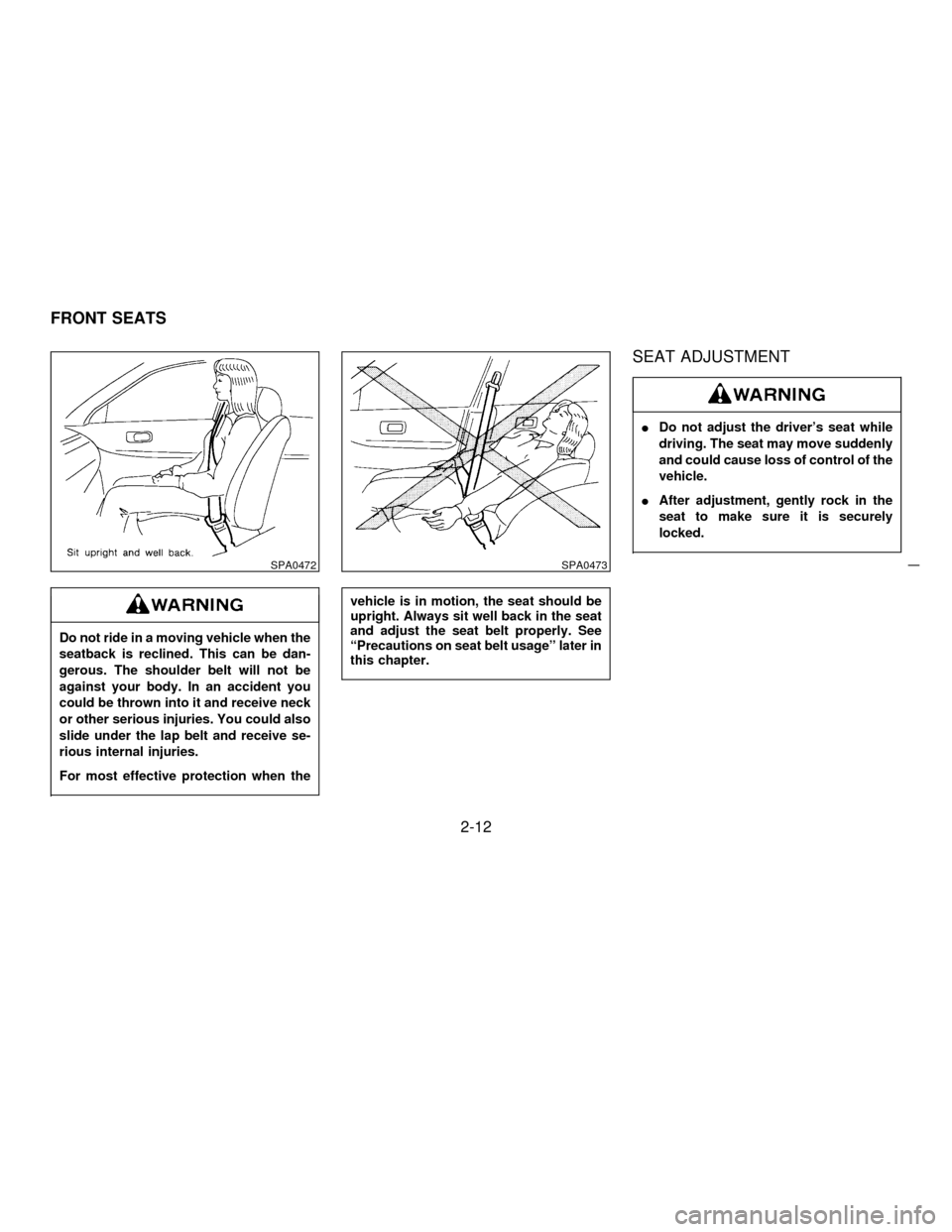1997 NISSAN PATHFINDER seat adjustment
[x] Cancel search: seat adjustmentPage 15 of 233

2. If the brake fluid level is correct:
Have the warning system checked by a
NISSAN dealer.
IYour brake system may not be work-
ing properly if the warning light is on.
Driving could be dangerous. If you
judge it to be safe, drive carefully to
the nearest service station for re-
pairs. Otherwise, have your vehicle
towed.
IPressing the brake pedal with the
engine stopped could increase your
stopping distance and braking will
require greater pedal effort as well as
pedal travel.
IIf the level is below the MINIMUM
mark on the brake fluid reservoir, do
not drive until the brake system has
been checked at a NISSAN dealer.
High beam indicator light
(Blue)
This light comes on when the headlight high
beam is on, and goes out when the low beams
are selected.
Seat belt reminder light
The light and buzzer remind you to fasten seat
belts. The light illuminates whenever the igni-
tion key is turned to ªONº, and will remain
illuminated until the driver's seat belt is fas-
tened. At the same time, the buzzer will sound
for about six seconds unless the driver's seat
belt is securely fastened.
Refer to ªSeat beltsº in the ªPre-driving checks
and adjustmentsº section for precautions on
seat belt usage.
Engine oil pressure warning
light
This light warns of low engine oil pressure. If
the light flickers or comes on during normal
driving, pull off the road in a safe area, stop the
engineimmediatelyand call a NISSAN dealer
or other authorized repair shop.
The oil pressure warning light is not de-
signed to indicate a low oil level. Use the
dipstick to check the oil level.See ªEngineoilº in the ªDo-it-yourself operationsº section.
Running the engine with the oil pressure
warning light on could cause serious
damage to the engine almost immedi-
ately. Turn off the engine as soon as it is
safe to do so.
Charge warning light
If the light comes on while the engine is
running, it may indicate that there is something
wrong with the charging system. Turn the
engine off and check the alternator belt. If the
belt is loose, broken, missing or if the light
remains on, see your NISSAN dealer immedi-
ately.
1-10
Z01.2.1/R50-DX
Page 42 of 233

2 Pre-driving checks and adjustments
Key ......................................................................... 2-2
Door locks .............................................................. 2-2
Multi-remote control system (If so equipped) ......... 2-4
Battery replacement ................................................ 2-6
Spare tire carrier .................................................... 2-7
Back door locks ....................................................... 2-8
Rear window locks .................................................. 2-8
Hood release .......................................................... 2-9
Glove box lock ..................................................... 2-10
Fuel filler lid lock .................................................. 2-10
Fuel filler cap ....................................................... 2-11
Front seats ........................................................... 2-12
Rear seats ............................................................ 2-16
Supplemental restraint system
(Supplemental air bag system) ............................ 2-19Warning labels ...................................................... 2-25
Supplemental air bag warning light ..................... 2-25
Seat belts ............................................................. 2-27
Child restraints for infants and
small children ....................................................... 2-34
Tilting steering wheel ........................................... 2-41
Sunvisors ............................................................... 2-42
Outside mirror control .......................................... 2-42
Outside mirrors .................................................... 2-43
Inside mirror ......................................................... 2-44
Luggage net .......................................................... 2-44
Luggage hooks........................................................ 2-45
Luggage rack ........................................................ 2-46
Z01.2.1/R50-DX
Page 53 of 233

Do not ride in a moving vehicle when the
seatback is reclined. This can be dan-
gerous. The shoulder belt will not be
against your body. In an accident you
could be thrown into it and receive neck
or other serious injuries. You could also
slide under the lap belt and receive se-
rious internal injuries.
For most effective protection when the
vehicle is in motion, the seat should be
upright. Always sit well back in the seat
and adjust the seat belt properly. See
ªPrecautions on seat belt usageº later in
this chapter.
SEAT ADJUSTMENT
IDo not adjust the driver's seat while
driving. The seat may move suddenly
and could cause loss of control of the
vehicle.
IAfter adjustment, gently rock in the
seat to make sure it is securely
locked.
SPA0472SPA0473
FRONT SEATS
2-12
Z01.2.1/R50-DX
Page 59 of 233

Pull the reclining lever and position the seat
back at the desired angle. Release the reclin-
ing lever after positioning the seat at the
desired angle.
IDo not ride in a moving vehicle when
the seatback is reclined. This can be
dangerous. The shoulder belt will not
be against your body. In an accident
you could be thrown into it and re-
ceive neck or other serious injuries.
You could also slide under the lapbelt and receive serious internal inju-
ries.
IFor most effective protection when
the vehicle is in motion, the seat
should be upright. Always sit well
back in the seat and adjust the seat
belt properly. See ªPrecautions on
seat belt usageº later in this chapter.
IAfter adjustment, check to be sure
the seat is securely locked.
Center armrest
Pull the armrest forward and lay it horizontal.
IC0385SPA0351
2-18
Z01.2.1/R50-DX
Page 72 of 233

When the cinching mechanism is activated the
seat belt cannot be withdrawn again until the
seat belt tongue is detached from the buckle
and fully retracted. Refer to ªChild Restraint
Systems for Infants and Small Childrenº later
in this section for more information.
The automatic locking mode should be
used only for child seat installation. During
normal seat belt use by a passenger, the
locking mode should not be activated. If it
is activated it may cause uncomfortable
seat belt tension.
Unfastening the belts
To unfasten the belt, press the button on the
buckle. The seat belt will automatically retract.
Checking seat belt operation
Your seat belt retractors are designed to lock
belt movement by two separate methods:
1) When the belt is pulled quickly from the
retractor.
2) When the vehicle slows down rapidly.
You can check the operation as follows:
IGrasp the shoulder belt and pull quickly
forward. The retractor should lock and re-
strict further belt movement.If the retractor does not lock during this check
or if you have any question about belt opera-
tion, see your NISSAN dealer.
Shoulder belt height adjustment
The shoulder belt anchor height should be
adjusted to the position best suited for you
(see ªPrecautions on Seat Belt Usageº). To
adjust, squeeze the release buttons, then
move it to the desired position so that the belt
passes over the shoulder.
IAfter adjustment, release the button
and check that it does not move up
and down to make sure the shoulder
PD1328MA
2-31
Z01.2.1/R50-DX
Page 76 of 233

In general, child restraints are designed to be
installed with a lap belt or the lap portion of a
three point type seat belt. Child restraints
specially designed for infants and small chil-
dren are offered by several manufacturers.
When selecting any child restraint, keep the
following points in mind:
1) Choose only a restraint with a label certify-
ing that it complies with Federal Motor
Vehicle Safety Standard 213 or Canadian
Motor Vehicle Safety Standard 213.
2) Check that child restraint in your vehicle to
be sure it is compatible with the vehicle's
seat and seat belt system. Choose a child
restraint that meets the guidelines of the
Society of Automotive Engineers recom-
mended practice J1819 for child restraint
installation.
3) If the child restraint is compatible with your
vehicle, place your child in the child re-
straint and check the various adjustments
to be sure the child restraint is compatible
with your child. Always follow all recom-
mended procedures.
All U.S. states and provinces of Canada
require that infants and small children be
restrained in approved child restraints at
all times while the vehicle is being oper-
ated.
INever install a rear-facing child re-
straint in the front seat. An inflating
supplemental air bag could seriously
injure or kill your child. A rear-facing
child restraint must only be used in
the rear seat. See ªInstallation on
front passenger seatº for details.
IImproper use of a child restraint can
result in increased injuries for both
the infant or child and other occu-
pants in the vehicle.
IFollow all of the child restraint manu-
facturer's instructions for installation
and use. When purchasing a child
restraint, be sure to select one which
will fit your child and vehicle. It may
not be possible to properly install
some types of child restraints in your
vehicle.
IIf the child restraint is not anchored
properly, the risk of a child being
injured in a collision or a sudden stop
greatly increases.
IAdjustable seatbacks should be posi-tioned to fit the child restraint, but as
upright as possible.
IAfter attaching a child restraint, test
the restraint before you place the
child in it. Tilt it from side to side. Try
to tug it forward and check to see if
the belt holds it in place. If the re-
straint is not secure, tighten the belt
as necessary, or put the restraint in
another seat and test it again.
IFor a front facing child restraint, if the
seat position where it is installed has
a 3-point type lap/shoulder belt,
check to make sure the shoulder belt
does not go in front of the child's face
or neck. If it does, put the shoulder
belt behind the child restraint.
IWhen your child restraint is not in
use, store it in the trunk or keep it
secured with a seat belt to prevent it
from being thrown around in case of
a sudden stop or accident.
2-35
Z01.2.1/R50-DX
Page 77 of 233

Remember that a child restraint left in a
closed vehicle can become very hot.
Check the seating surface and buckles
before placing your child in the child
restraint.
Installation on rear seat
Center lap belt
When you install a child restraint in a rear
center seat, follow these steps:
1. Position the child restraint on the seat as
illustrated. It can be placed in a forward
facing or rear facing direction, depending
on the size of the child. Always follow the
restraint manufacturer's instructions.
2. Route the seat belt tongue through the child
restraint and insert it into the buckle until
you hear and feel the latch engage. Be sure
to follow the child restraint manufacturer'sinstructions for belt routing.
3. Remove all slack in the lap belt for a very
tight fit by pulling forcefully on the lap belt
adjustment.
4. Before placing the child in the child re-
straint, use force to tilt the child restraint
from side to side, and tug it forward to make
sure that it is securely held in place.
5. If it is not secure, try to tighten the belt
again, or put the restraint in another seat.
6. Check to make sure the child restraint is
properly secured prior to each use.
SPA0276
2-36
Z01.2.1/R50-DX
Page 231 of 233

S
Safety
Child safety................................................ 2-28
Child safety rear door lock .......................... 2-3
Driving safety precautions ......................... 4-21
Reporting safety defects (For U.S.A.) ....... 9-20
Seat adjustment .............................................. 2-12
Seat belt
2-point type with retractor (Center position of
rear seat) ................................................... 2-32
3-point type with retractor ......................... 2-30
Precautions on seat belt usage ................ 2-27
Seat belt extenders ................................... 2-34
Seat belt maintenance .............................. 2-34
Seat belts .................................................. 2-27
Semiautomatic air conditioner .......................... 3-7
Spare tire carrier ............................................... 2-7
Spark plug replacement .................................. 7-14
Speedometer and odometer ............................. 1-3
Spot light ......................................................... 1-31
Starting
Before starting the engine ........................... 4-7
Jump starting ..................................... 5-7, 7-13
Precautions when starting and driving ........ 4-2
Push starting ............................................... 5-9
Starting the engine .................................... 4-13
Steering
Power steering fluid................................... 7-11
Power steering system .............................. 4-24
Tilting steering wheel ................................ 2-41
Sunroof (If so equipped) ................................. 1-29
Sunvisors ........................................................ 2-42
Supplemental air bag warning light ................ 2-25Supplemental restraint system (Supplemental air
bag system) .................................................... 2-19
Switch
Front fog light switch ................................. 1-19
Hazard warning flasher switch .................. 1-19
Headlight and turn signal switch ............... 1-15
Ignition switch .............................................. 4-5
Rear window defroster switch ................... 1-18
Rear window wiper and washer
switch......................................................... 1-17
Windshield wiper and washer switch ........ 1-16
T
Tachometer ....................................................... 1-4
Theft warning (If so equipped)........................ 1-13
Three-way catalyst ............................................ 4-3
Tilting steering wheel ...................................... 2-41
Timing belt ...................................................... 9-10
Tire
Flat tire ........................................................ 5-2
Spare tire carrier ......................................... 2-7
Tire placard ............................................... 9-14
Tire pressure ............................................. 7-26
Wheels and tires .............................. 7-26, 9-11
Tonneau cover ................................................ 1-26
Tow truck towing ............................................. 5-10
Towing
2-wheel drive models ................................ 5-11
4-wheel drive models ................................ 5-12
Tow truck towing ....................................... 5-10
Towing load/specification chart ................. 9-18
Trailer towing ............................................. 9-16
Trailer towing .................................................. 9-16Transmission
Automatic transmission fluid ....................... 7-9
Driving with automatic transmission............ 4-7
Driving with manual transmission ............. 4-11
V
Vanity mirror light ............................................ 1-31
Vehicle identification ....................................... 9-13
Vehicle identification number (Chassis
number) ..................................................... 9-13
Vehicle identification number plate ........... 9-13
Vehicle loading information............................. 9-15
Vehicle recovery (Freeing a stuck
vehicle)............................................................ 5-13
W
Warning
Hazard warning flasher switch .................. 1-19
Supplemental air bag warning light........... 2-25
Theft warning (If so equipped) .................. 1-13
Warning labels........................................... 2-25
Warning/indicator light and buzzer.............. 1-9
Wheels and tires ................................... 7-26, 9-11
When traveling or registering your vehicle in an-
other country ................................................... 9-12
Window washer fluid ....................................... 7-12
Windshield wiper and washer switch.............. 1-16
Wiper
Rear window wiper and washer
switch......................................................... 1-17
Windshield wiper and washer switch ........ 1-16
Wiper blade ............................................... 7-17
10-4
Z01.2.1/R50-DX